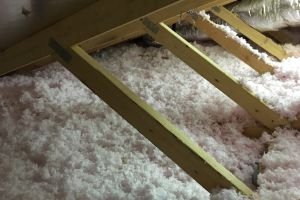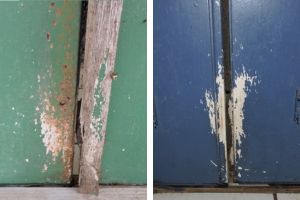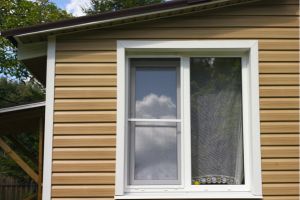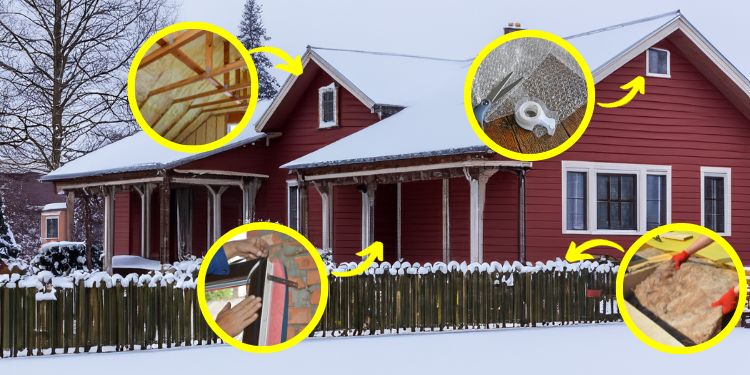The first snow flurries of winter are just around the corner. For some, living high enough up in the mountains, they’ve already come. We can expect a wet, cold winter this year, thanks to the effects of El Niño.
The question is, are we ready for that cold to hit us? Energy prices are rising, meaning that this might be a very expensive winter, when it comes to keeping our homes warm.
If you live in an older home, chances are pretty good that it is not well insulated. On top of that, the windows and doors might not seal as well as they once did, allowing air leaks that will bring cold air in and let your heated air escape.
Even newer homes might have these problems, as the quality of workmanship in building the home and the components that went into it can make even new homes leak air. The biggest air leak I found in my home was the patio door in the family room, which is in the newest part of the house.
Age also affects the insulation in the attics of our homes. Insulation in the walls doesn’t settle much, as the paper liner for the insulation holds it in place.
But the insulation in our attics is not required by building code to have that paper liner. Even if it does, it won’t prevent gravity from packing the insulation down. What may have started out as 14 inches of insulation, could only be 8 or even 6 now.
Related: How to “Winterize” Your Pipes and Prevent Damage
Fortunately, it’s not too late to prepare our houses for the coming winter. Winterizing a home really isn’t as difficult and mysterious as people make it sound. You can accomplish a lot, just taking care of air leaks and making sure your attic insulation is up to snuff.
Attic Insulation
 Let’s start with the attic insulation, as that’s the place you can get the most benefit, for the amount of work that you’ll need to put in.
Let’s start with the attic insulation, as that’s the place you can get the most benefit, for the amount of work that you’ll need to put in.
The first thing to do is climb up there with a tape measure and a flashlight, to inspect the insulation and determine just how deep it is.
When measuring the insulation, you want to be sure to measure its thickness to the drywall that forms the ceiling below, rather than to the tops of the ceiling joists. Take care not to step on the insulation or drywall, as it cannot support your weight.
If you live in the north, you want to have 16 to 18 inches of insulation. If you live in the south, 13 to 14 inches is adequate.
The easiest and most cost-effective way of adding insulation to your attic is to use blown-in insulation. There are two basic types available: fiberglass and cellulose. The fiberglass costs more, but it lasts longer as well, so in the long run, the choice ends up being a trade-off; cost for time.
Related: Ancient Types Of Homes You Can Build For Cheap
If you buy at least 10 bales of blown-in insulation at any of the major home improvement centers, they will provide you with the machine to blow it in for no rental charge. You will probably need two pickup trucks or two trips with one truck to get both the machine and the insulation home. Once there, two people can insulate an attic in just a few hours.
You need two people so that one can keep loading the machine with more insulation, while the other is up in the attic, spreading the insulation around with the blower. Start from the furthest part of the attic and build the insulation up to the desired depth. Work your way back to the entryway, making sure you don’t miss any parts and that you keep the depth consistent.
Although I said “don’t miss any parts,” if your home has vents in the eaves, you’ll want to be sure not to cover them up, as they are there to allow airflow through the attic. That’s important for your home’s cooling in summertime. So, be sure to check for that before starting and mark where those vents are, so that you don’t accidentally cover them.
Dealing with Air Leaks
 The other major part of winterizing your home is dealing with air leaks. This is something that the average homeowner can do themselves.
The other major part of winterizing your home is dealing with air leaks. This is something that the average homeowner can do themselves.
The challenging part is finding the leaks. But since they are almost always around the doors and windows, that limits your search somewhat.
If you have trouble finding the air leaks in your home, try using a lighted candle. Run the candle around the borders of your windows and doors, watching the flame. Any air movement, in or out, will cause the flame to bend either away from the wall or towards it, showing you where the leak is.
Most of these air leaks can be fixed with self-adhesive rubber weatherstripping, which you can buy at any lumberyard or home improvement center.
Size is important, as too large a weatherstripping will keep doors and windows from closing properly, leaving an air leak. If the weatherstripping is too large, it keeps the door or window from seating all the way. If it is too small, it doesn’t fill the gap.
I’ve found it is best to buy a few different sizes, which allows me to pick the best possible size for each air leak. That allows me to seal the gaps off much better than trying to use the same size everywhere. The weatherstripping isn’t very expensive and will save you more money than what it costs you.
There may be some cases where the home’s trim doesn’t cover something properly, making it impossible to seal the gap with weatherstripping alone.
These pictures below show the bottom of a pair of French doors that can’t seal properly (blue is inside, green is outside).
As you can see from the pictures, there is a considerable gap, which can be seen through. The existing foam weatherstripping, which is damaged, really can’t fill that big a gap well.

This problem goes back to when the doors were installed. Whoever did the installation, didn’t shim the door frame properly.
So, the gap between the doors is much bigger at the bottom of the doors, than it is at the top. Fixing it would require removing the doors and trim, then reinstalling them properly.
Related: 8 Items You Need to Survive a Power Outage This Winter
Adding to the original problem, the original owner’s dogs scratched at the doors, especially the trim piece that was to cover any gap between the doors. Even if the doors were rehung, it is doubtful that the damaged trim would adequately cover the gap.
The solution, in this case, is not only to install new weatherstripping; but also to make a new trim piece to overlap the gap between the doors. It should be wider than the original, ensuring that it will adequately cover the gap.
It should also be made of a solid hardwood, like 1” oak or maple, ensuring that it is strong enough to withstand any efforts by thieves. While it would normally be attached from the outside, additional screws should be driven through the door from the inside, ensuring that thieves couldn’t remove it with a pry bar.
Such damage can happen with any older or remodeled home, especially in cases where the homeowner did the remodeling job themselves.
Not everyone who does that really understands what they are doing and just watching YouTube videos may not teach them well enough.
Nevertheless, such a repair, whether on a door or window, will do a lot to help eliminate such air leaks.
What About Windows?
Of all the home, the parts which provide the least amount of insulation are the windows. Single pain windows have an R-value of 0.91, which is considerably lower than even an uninsulated wall has (3.0).
 If there’s any place in our homes, which needs more insulation, it’s the windows. But replacing old windows with new ones is an expensive proposition.
If there’s any place in our homes, which needs more insulation, it’s the windows. But replacing old windows with new ones is an expensive proposition.
Few of us can afford to spend an average of $700 per window to replace the windows in our homes. That’s not to say that there’s nothing that we can do.
Related: 24 Prepping Items I Don’t Spend Money On
There are two easy and inexpensive ways of increasing the R-value of windows, neither of which requires replacing the widows.
The first of these is to apply bubble wrap to the inside of the windows. Yes, you heard me correctly. I’m talking about the kind of bubble wrap that is used to package fragile items for shipping, which we all love to pop.
You can buy that bubble wrap in rolls, cut it to fit your window glass, and attach it to the inside of your windows. To attach it, simply spray the window with a small amount of soapy water, then apply the bubble wrap, bubble side to the window.
As the water dries, the soap acts as an adhesive to hold the bubble wrap in place. Bubble-wrapped windows have an R-value of about 2, which is about the same as double-pane windows with a ½” air space.
The second way of improving the R-value of windows is to cover the inside of the window, frame and all, with clear plastic. 3M produces a window insulator kit, that includes a very clear, heat shrinkable, clear plastic film, with an attachment method. Once installed and heated to shrink it, it is virtually invisible, allowing you to look through your windows.
You can do something similar, for a lower price, using clear plastic sheeting, of the kind that contractors use for drop cloths. It won’t come with an attachment system, but you can staple it to the window frame or window trim on the inside of the window, creating an air space.
This isn’t optically clear, so it is hard to see through the window; but it lets light in just fine. A window covered in this manner has an R-value of 1.76.
Adding those two methods together, the bubble wrap and the window film, you should be able to gain an R-value for your windows of roughly 2.75, without spending a whole lot of money.
You may also like:
 The Ultimate Survival Food You Can Only Harvest This Winter
The Ultimate Survival Food You Can Only Harvest This Winter
How to Build an Endless Hot Water System Without Electricity (Video)
25 Common Prepping Items You Don’t Really Need















Like most of us we should have done the weatherization during the Summer than wait to last minute as usual.
Most are repairs to the last Winter, Spring weather damage. That we have not gotten to because of bidenomics, we are living paycheck to paycheck era.
Stuff is expensive to purchase because of unionized employees demanding higher wages which cause higher prices. Makes repairs much more expensive on us and fixed income seniors too.
Latest news flash in NYC! Current events for preppers.
Interesting tidbit NYC mayor Adams cell phone were confiscated for evidence of election corruption by funds from the Turkish government by the FBI.
Other note Adams ha criticized Biden on the border issue of illegals coming to NYC.
Why not check every high ranking politicians of all parties of their cell phones for corruption as they become millionaires over night. And funnel assets to their family members to hide their wealth from the IRS.
Let’s check all 2024 presidential candidates, they are not above the law.
Start with CA gov Newsom who recently chummed around with the Chinese dictator.
Newsom used taxpayers money to buy Chinese made Covid masks than support American mask manufacturers in the USA.
See what California’s homeless and economy is a peek into what he will do to the rest of our nation as president.
Newsom and Michelle Obama will be an extension of the soft dictator president Obama was and is behind the scenes in Biden’s administration.
We all know Biden is too senile to run the presidency. Who really is pulling the Marxist puppet strings.
If you live some counties the building materials needed have been restricted by bureaucratic policies. For some environmental fearmongering of materials supposedly used in building materials. I am tired of political legal nonsense over what is practical needed for us to use at cheaper prices to fix our homes.
A neighbors tree next door has a tree root that recently cracked my garage concrete floor. I can repair it nonprofessional or thinking about calling a repairman to do it. The only difference is material cost is about the same, it is the labor costs.
Some of the repair projects do require a more professional hand. It is the increasing cost of higher paid employees that make us muddle through our repairs and hope for the best results.
The average home owner does not keep those special tools that make job a snap to do. So the decision is call a pro or do it yourself of varying results.
If a tree root grew under your slab you need to check for a water leak.
The garage slab should not have a water leak unless water pipes are underneath the slab. On the West coast New home construction foundations have concrete slabs with water pipes buried inside the slab. Eventually these water pipes start to leak. The homeowner must call a plumber to repair those leaks.
The older homes were built on raised brick foundations. That have crawl spaces, easier for repairs.
The Northern regions homes have basements so water leaks are easier to get at for repairs. Those basements do get ground water leaks in the foundation walls. Had a couple of those leaks, five years ago, was lucky to repair them myself.
Related off topic; Energy needed at night for repairs in a suburban environment, most of us don’t live in the country.
What happens the windmills stop working the supply of electricity is gone. Solar panels only work during intense daylight, we need the electricity at night. Grid tie is great daytime hours. The city utilities have not gotten to the electrical storage phase of high quality constant stable supply for night work.
“In Wyoming, cheap electricity is gone with the wind, Gov. Mark Gordon defends his “all of the above” green energy boondoggle as good policy. But ratepayers are learning the hard truth that wind power is neither cheap nor effective.”
Gordon claims to support coal. The trouble is that he’s shackled its use to “carbon capture,” an expensive and cumbersome process designed to sequester carbon dioxide, the “greenhouse gas”
Gordon supports the electric car grift as head of the Western Governors Association with its “Electric Vehicle Roadmap Initiative,” which will further strain our electric grid and drive up prices even more.
Siemens, Germany’s large wind producer. After blaming its billions in operating losses on a “substantial increase in failure rates of wind turbine components,” the company leaders claim the German government is prepared to offer a $16 billion bailout to the country’s wind energy industry. Don’t be surprised when U.S. taxpayers have to pay to keep an industry afloat that in itself is contributing to higher rates for consumers.” – The Blaze short version.
Yes this country has gone bonkers on the green energy facade we are bombarded everyday by the climate change experts.
EV’s, wind mills are of the fantasy of Don Quote story. We need greenhouse gases for the planet to survive. Trees need carbon dioxide to live and they give us oxygen for us to breath.
Environmentalist and unions run our policies of stupidity. Many of those liberals have drunk the koolaid too many times. Remember Jim Jones or the Heaven’s Gate cults, anyone remember, manipulation of our minds.
Green energy, climate change, carbon footprint all mad up to control us like religion and politics of the globalist elite we vote into politics world wide.
Quit going to college and universities for a lifetime of economic woes of how to pay for useless degrees. Medical, legal, engineering fields are the higher form of trade schools that teach useful skills.
To fill a seat to listen to a Marxist professor whose job is paid for by taxpayers, benefactors have tenure, you don’t. Many students can’t afford the student loan.
Many kids and adults should do more trade school skills. Then they can afford to pay for a college education, than have taxpayers bail there student loans out.
These leaders and transplants from liberal States come to conservative States to turn Blue States into liberal hell. Just stay in your crappy States and fix them to conservative standards instead.
Liberals go home and some of you liberals go back to your home countries. We were happier before you all messed with our politics and religion of our young kids.
With liberals it is not from the river to the sea here, it is from sea to shinny sea of our coasts in American liberalism. Let’s take our country back now.
Now , wheather tight , people proof, set up stop gaps for the incoming stupid which now you cannot communicate with and could possible get you killed , because your a unsuspecting person from the old times.
subscribe to Mazazines for hunting, fishing, bowhunting, riffles, guns, ammo , so you can be ahead of the game
Learn to use lite to detect leaks , smoke to detect incoming opens , noise so you can see if it is sound proof
Turn on all the lites , close everything up, go out in the pitch dark , see what comes thru
or turn everything inside completely off, have someone go out shine very bright lites in thru the cracks, seems, areas you think leak
simple but they work .
just like how God made everything to have a structured process of troubleshooting , the true how it works , common sense
Too Tight , creates gas build up , need a little ventalation for fresh and good air
Can you use spell check and fix the spacing of your commas?
I have design/built for 50 years. Very early in my career and during students days in NYC in a STEM program, I felt the huge benefits of mitigating air gaps at windows and other areas. First Winter w/out…COLD, Second Winter w/rope caulking….WARM & Comfort! I insulate under slabs(40+ years), R-50 in roof/ceiling assemblies, R19 in the walls and plenty of ventilation to avoid rot. I should have written this article, maybe next year I will, lol. One further advice: If you have an old frame house, do what they do up in Minnesota, take 6 mil clear plastic over the entire house, all sides and attached with a commercial staple gun. It is temporary but will make a huge difference in heat loss until you figure more permanent ways to do it. Might cost $60….about 25 gallons of heating oil.
The downside to plastic on every window does not allow for outside air ventilation if there’s a thaw, and, more importantly, will make it tougher to use as an emergency egress during a fire.
A design solution that’s fallen out of fashion favor at the moment is really heavy drapes. A local restaurant tacked up a huge heavy drapery at its entrance to minimize the a.ount of cold air rushing in whenever the front door opened. It was nice quality and carefully hung so it didn’t look hideous, for those whom aesthetics are paramount. I was amazed at what a great job it did keeping the draft out.
We weren’t seated far from the front door and were not at all uncomfortable at our table.
Since drapery is not trendsetting these days, oneught be able to score a good deal, especially going to thrift stores and looking through the curtains.
I have the large window blinds on all my windows, over that a sheer curtain, over that light reducing drapes. It has made a huge difference in keeping the house warm. On the NW side of the house I also have translucent vinyl on the windows. My house is 30+ years old. I am old and I don’t like the cold or high heating bills. Lol
Thanks for your comment! I live in Gov. housing. The management isn’t very interested in making improvement of or “Fixing anything!” Yes, I’m in the same age category as you, not liking to be COLD! The complex I have lived in for 12 plus years wasn’t the “BEST built complex!” The rooves in the heat of summer sage between the rafters that look like they’re three feet apart! The sheathing is less that half-inch thick! Brick building! Floors creak when walked upon! How many floor joists? Probably like the rafters? But it beats living out of a vehicle or under a bridge! Thankful!
Would using the bubble wrap and/or plastic help for heat coming through windows? I live in Arizona and the morning sun beats through 2 of our windows and heats up the bedrooms. I have dark curtains over them, but I can still feel the heat coming through.
Spray foam your house! Everywhere you can. We got-48 below last winter. Couldn’t tell in my cabin. The windows aren’t even caulked. Sure wish I would have known how well this stuff worked long ago. Worth every single penny.
The same areas need focus for summer-prep too. Sandgroper representing for the southern hemisphere!
Windows – work out how you’ll keep the sun off them to keep your house cooler. Ideas include planting fast growing shrubs in front of them (or slower ones and trying other ideas until they fully grow), nailing some shade cloth to a length of 4×2 and using it as a temporary curtain hanging from your gutters, or installing roller shutters that you can put down. Good curtains help keep the cold out/heat in, but by the time the sun hits your window it’s already inside your house so you need ot stop it hitting your window first. Protect west and east walls from direct sun as well. Consider larger changes like painting dark coloured roofing or rearranging which rooms you sleep in to improve your living situation.
Insulation – hot air rises. Make sure you have a form of insulation and venting. An insulated house will retain its cool longer, and if you can plan to vent hot areas (run that exhaust fan when cooking!) that’s a win.
Air flow – is where it’s at for management of a sweating house. Plan to open your house in the cool hours (particularly just before dawn), and shut it down and keep it dark and quiet in the hot hours (mid / late afternoon in particular).
Core body temperature – cooling your body thoroughly can be really helpful to coping with heat. Find time to bath, shower, swim or lie on cold concrete floors for a good fifteen minutes a day, in cooler than body temperature water. The goal here is not to get icy cold, but comfortably cool down.
Do your fire and snake prep…. Clear the ground all around your house, check your water tanks are full ready for a fire truck to fill if needed, bait mice as they move in hungry (snake food), and cut back over grown spring plants.
To seal my windows for winter,
I just take scotch wide tap and put a round the seams. .
and it works great,
No cold air comes in, No need to put up all that plastic, .
Got dust mites, But l antiseptic mouthwash in a spray bottle , and will get rid of other bugs as well. , even flees.
And you can use the equate brand.
Bought a house a bout two years a go with this problem and it seamed every thing I tryed in rotch spry never seam to work, They all come back in a bout to days, so I got the wild idea, , and just wait a few hours, But on a mask when you do this and let it set for 3 hours close windows and door And you will not have to air it out, but that. s up to you.
I even used bleach , in a spray bottle , but you must air out the room , Clothing and bedding remove before using bleach , Yes its mean way to get rid of them . But it worked for me. , Not buying all those sprays that say it kills on contact and keeps killing up to 4 moths, I think your killing your self in the long term .
This is my favorite web site on the net,
These are some great comments and vary helpfull.
This site help make life better and great information
by what other people share with there knowlage.
Thank you
Larry